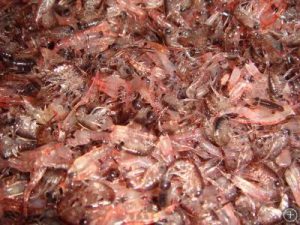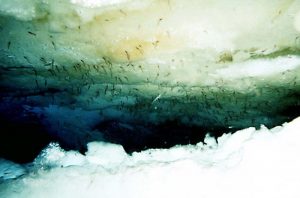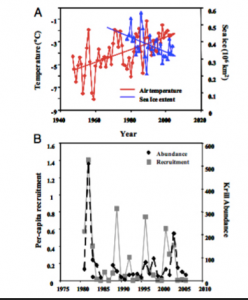Krill’s Rapid Decline; Small Scale Manifests a Larger Scaled Result
By Casey Dresbach, SRC Intern
Krill (Euphausia superba) are small crustaceans found in all of the world’s oceans. They rely on small phytoplankton, single-celled plants as their food source that drift near the ocean’s surface. The tiny primary consumers rest at the bottom of the ecological marine food pyramid yet are key to the diets hundreds of different animals ranging from terrestrial to aquatic organisms. Because these organisms are situated at the lowest trophic level, they are forced to support all life in the above levels. If they were to be extinct in a day, there would be an off balance in the interconnected food web and populations between the ocean and parts of terrestrial regions would spiral down their declines.

A zoomed in image of an abundance of Krill. In terms of biomass, they are the most successful in terms of proliferation in the world’s ocean.
A few of the organisms that feed on Krill include sea birds, fish, baleen whales, and penguins. Their relative small size has little do with the large impact they have on the organisms several times their relative dimension. In terms of their numbers, one might question how such small organisms can support a large baleen whale. Krill gather into dense swarms that can have from 1,000 to 100,000 individuals per cubic yard (1 cubic meter), and a swarm can extend from 30 feet (10 meters) to almost 4 miles (6 km) in length. With this strategy they are able to concentrate areas of distribution and make reproduction fairly easy and attainable with such proximity.
The seven characteristics of life include the several aspects an organism must attain to survive as an individual. The most relative to Krill specifically is, “living things adapt to their environments. The most “primitive krill” had to adapt to a specific habitat and only then the survival of the fittest could come into play and those who were best suited would grow and reproduce and hence manifest a greater population. Their strongest adaptation supports their best suiting habitat, sea ice. Their relationship with sea ice is beneficial; it acts as both shelter and a feeding ground for larval and juvenile krill in the winter and in Antarctic regions year round. Temperature is favorable to the key stone species as well as green and blue algae. Krill have evolutionarily become accustomed to this habitat and have thus amplified in such regions.

Krill habituate on sea ice primarily for favored temperature, but also as an easy locus for their algal food source.
There are two critical aspects leading to a sharp decline in the keystone species. Sea ice loss is of significant concern to krill and the several species it feeds. Climate change is to blame for the gradual melting of the habitats. An increase in temperature – having much to do with global warming – is shrinking the sea ice in both the summer and winter. Krill struggle to adapt to such a difference in temperature and cannot survive. Their failure to survival has led to a decrease in their numbers by about 80% since the 1970s, according to several experts. The second agent to point a finger at is the excessive amount of krill fishing in Antarctic waters. Krill are targeted for their supplementary advantages they can offer pet food and food fertilizer. But most recently, have been found to be a great source of omega-3 fatty acid supplements that ultimately make their way into the pharmaceutical vitamin world or the cosmetic industry.
In an effort to better investigate the long-term changes in the physical environment and how they pose a threat to the ecological marine food web, Wayne Z. Trivelpiece, Jefferson T. Hinke, Aileen K. Miller, Christian S. Reiss, Susan G. Trivelpiece, and George M. Watters conducted a study in Antarctica. Sea ice in the West Antarctic Peninsula (WAP) and Scotia Sea are hypothesized to affect penguin populations directly. The specific species included the Adélie penguin (Pygoscelis adeliae) and the Chinstrap penguin (Pygoscelis antarctica). The Adélie favor ice packed habitats in the winter whereas the Chinstrap favor ice-free water to thrive. They performed a series of analytical studies to ultimately come to the conclusion that it is not solely the melting of the sea ice causing the decline in numbers, it’s the interplay of the melting and the limited availability of krill in the ocean to nutrient the penguins. These researchers compared large-scale changes in krill populations and physical conditions in both the Scotia Sea and the WAP. The relative abundance and recruitment showed a direct correlation among suitable environments including temperature as a key factor. Since krill were responding poorly to the temperature, they were dying out, and were absent for the penguins to eat.

Researchers Wayne Z. Trivelpiece, Jefferson T. Hinke, Aileen K. Miller, Christian S. Reiss, Susan G. Trivelpiece, and George M. Watters compared relative krill abundance in both the Scotia Sea and WAP in regards to several variables including: temperature, per-capita recruitment, and sea ice extent.
If global warming continues to dominate, sea ice will continue to melt and krill will continue to lose their habitat. Without sufficient krill, penguins among many the krill’s many other predators will decline (Wayne Z. Trivelpiece, 2010)e too. Understanding how krill demography is affected by changes in the physical environment poses an outlook to predicting future changes in marine ecosystems. A single or double occurrence that happens at a small scale can have a pleiotropic affect on something grander, i.e. the marine food web.
Bibliography
(n.d.). Retrieved November 11, 2015, from Ice Stories Exploratorium:
http://icestories.exploratorium.edu/dispatches/big-ideas/krill/
Jonathan B Shurin, D. S. (2006, January 7). All wet or dried up? Real differences between aquatic and terrestial food webs. Retrieved November 11, 2015, from The Royal Society Publishing: http://rspb.royalsocietypublishing.org/content/273/1582/1
Wayne Z. Trivelpiece, J. T. (2010, November 10). Variability in krill biomass links harvesting and climate warming to penguin population changes in Antarctica . PNAS .
